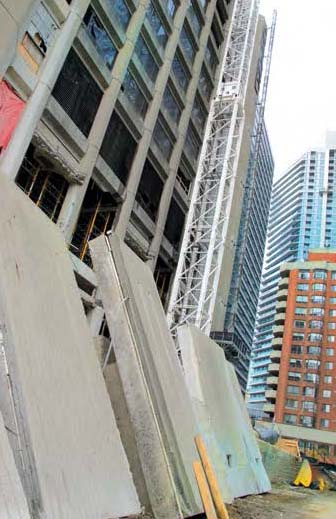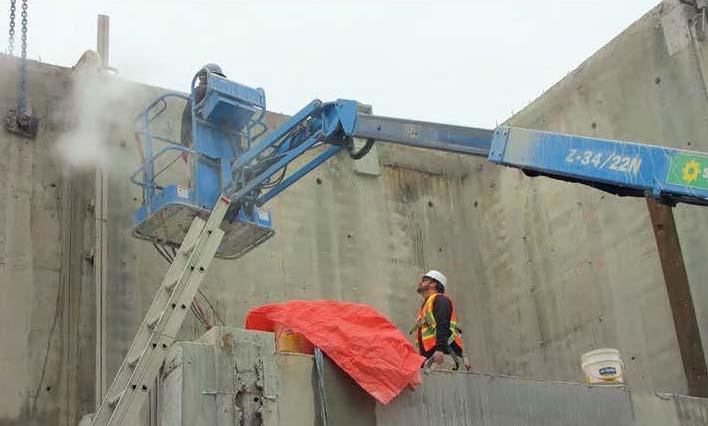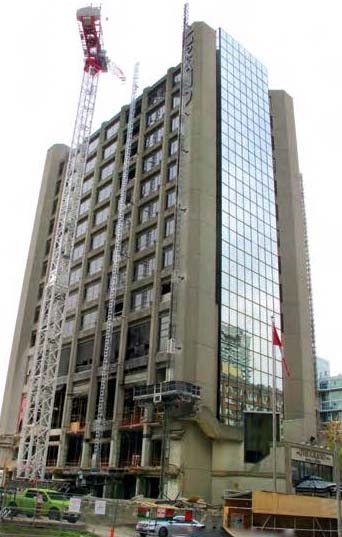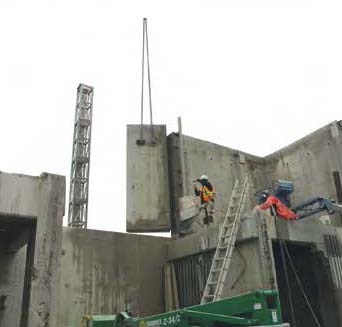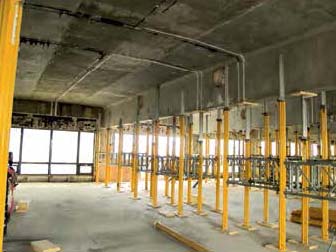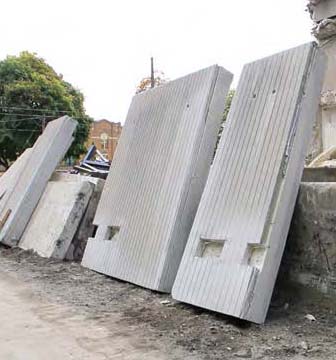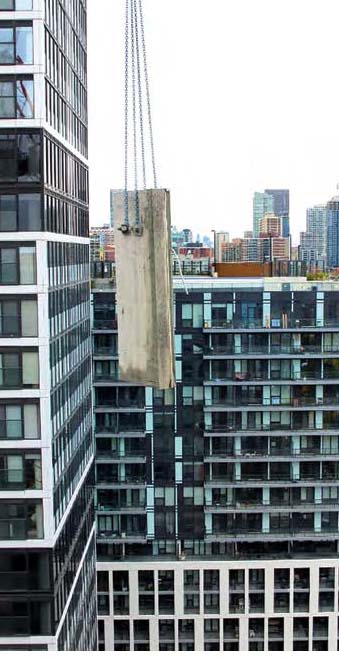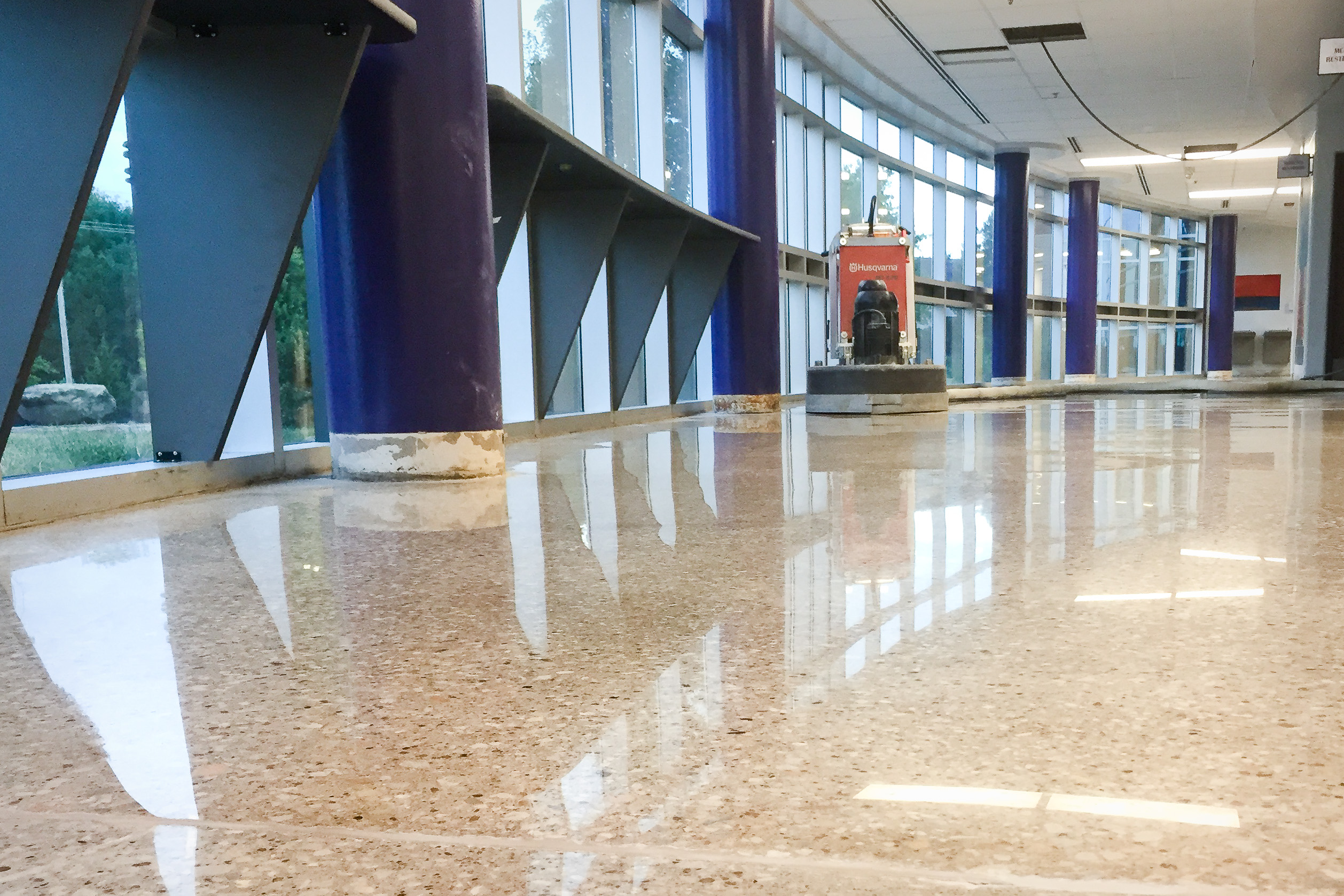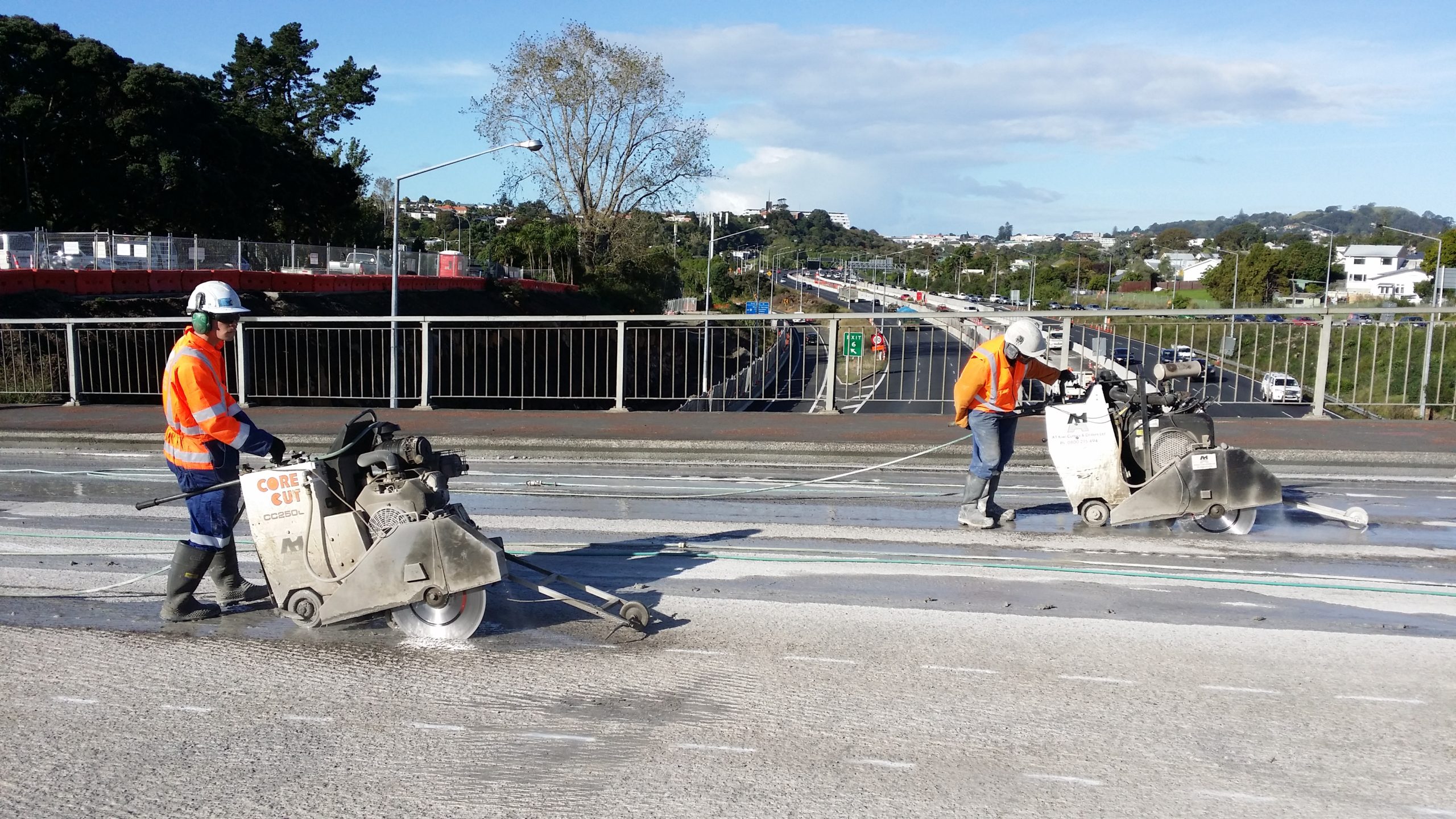
GRAND HOTEL REDEVELOPMENT

The city of Toronto, Ontario, Canada is experiencing a growth in hotel redevelopments in its downtown core from the construction of new, boutique style hotels, to high-end residential condominiums. One of the major projects is the demolition and redevelopment of the Grand Hotel, located at 225 Jarvis Street. The Grand Hotel has significant historical importance to the area. Originally built in 1972, it served as the headquarters to the Royal Canadian Mounted Police until 1993. Later, it was converted into a 177-suite hotel. Plans to redevelop the property proposed the addition of a 45-story condominium tower, integrating the existing 17-story structure adjacent to the building.
GFL Environmental, based out of Toronto, is a leading North American provider of diversified environment solutions. They were awarded the contract to complete the initial abatement, and strategic structural demolition of the hotel. GFL Environmental and CSDA member Ontario Cutting and Coring Ltd. (OCC) have had a close working relationship on several previous, complex projects. For this reason, OCC was consulted to evaluate the plan and develop the safest, most cost effective and efficient methodology to complete the concrete cutting of the structural components of the building.
The existing 17-story Grand Hotel structure required both interior and exterior demolition to move forward with the development. Demolition proceeded ahead of the massive tower construction. Due to strict municipality construction and Toronto’s Tall Building guidelines that limit space between buildings under construction, OCC began by scanning the area using ground penetrating radar (GPR) with a GSSI Structurescan Mini XT to confirm the locations of pre- and post-tensioned cables and rebar. GFL’s engineer and Chris Volpe, Vice President of OCC, then used the data to develop optimal cutting procedures. The location of the cuts had to be marked to ensure the structural integrity of the remaining floor areas would not be compromised, but also allow for floor slab removals. Once the building was scanned, demolition commenced.
GFL completed all interior removals, including decommissioning of electrical and mechanical systems, abatement and non-structural removals. GFL proceeded with this work floor by floor ahead of OCC. The engineer and OCC operators reviewed cut sizes, equipment capacity and crane selection that could not only handle the work, but also fit into the building. This all factored in to determine maximum size of concrete blocks that could be cut. OCC utilized GFL’s tower crane to lift the necessary equipment and supplies to the roof. OCC then used a combination of wall, slab and wire saw equipment to cut and remove pieces all under the strict guidance of a structural demolition engineer.
OCC completed suspended floor slab, walls, T-Beams, ring beams and column cuts from the 17th floor (roof level) to the 3rd floor, working their way down. There were challenges getting staff, equipment, supplies and water to the roof, as there were no elevators in service and only a single crane on site. All major pieces of equipment being lifted were coordinated by booking the tower crane in advance. As power to the building and elevators were shut off, staff had to climb 17 floors to the roof and downward as work progressed. Dispatch Manager Nate Rogers and Operations Manager Mark Zapparoli joked that OCC tended to mobilize their younger staff for this work. The staff were exposed to high wind and cold weather conditions as work commenced late fall. Additionally, the exterior blocks of the building were removed, exposing everyone to the elements. The cutting had to be planned in a way to ensure wind was blowing away from the wall/slab/beam that was being cut.
The OCC team used Diamond Products FZ-4S wall saw with a 72” blade, Husqvarna WS482HF wall saw and a Hilti DST20-CA wall saw, both of which were equipped with Diamond Products Tactical Grain Distribution blades, to begin wall sawing the roof and penthouse floor wall. A Diamond Products CSH24 Chain Saw and a Husqvarna WSC40 chain saw with Diamond Products Heavy Duty DCCP9824PG diamond chains were used for cutting the tight concrete areas. A Diamond Products Core Cut WS50-XLE High Cycle, Husqvarna CS10 and Hilti WS3018 wire saws with Diamond Products DWHP2S diamond wire were also utilized by the OCC team for the T-Beam, Ring Beam and column removals. A Husqvarna 7000 Series hand tool and a Diamond Products Pro Series 25” Flush Cut 5803016 hand tool dismantled the tight areas. Core drills were needed to eliminate overcutting. Diamond Products M2A-23-DK22 Anchor Drill Rigs with Diamond Products Premium Black Turbo TPOWL core bits were used to drill thousands of holes of various sizes. Finally, a Diamond Products Core Cut CC7574DDC-48 deck saw with Diamond Products TGD CMPTGDR blades was used to slab saw the floors.
The 3rd floor was completed using a more traditional demolition technique, hammering, by GFL. Each floor demolished was similar in composition and included 28 columns each, weighing a whopping 9 tons per column, as well as a 50-ton T-Beam. Each floor also had 14 Ring Beams removed weighing 8 tons each, and nine infill slabs, each weighing 20 tons. The two penthouse structures that were removed each weighed 350 tons.
During operations, an engineer from GFL was on site to inspect the procedures. Engineered drawings were prepared and submitted to the owner’s engineer for review prior to any dismantling. Daily onsite, pre-work staff meetings were held at the start of each day to review daily work activities and coordinate crews working in specific locations. Any Job Hazard Analyses (JHA) were adjusted to reflect specific daily activities and revised as job conditions changed. The Ministry of Labour required PPE, including a hard hat, safety vest, 8” high CSA approved boots, safety glasses and harness be worn by staff at all times.
With the size of their organization, OCC dispatch manager, Nate Rogers, was able to manage the required crews based on the anticipated scope of work, weather conditions and GFL workforce to assist OCC. The core group dedicated to this project included Mark Zapparoli, Dean O’Leary, Kyle Petrie, Mario Tricarico, Joe Tomiczek and Jeremy Stade.
Concrete cutting was implemented over traditional demolition methods due to the height of the building
and proximity of adjacent buildings, as the tight working conditions and noise restrictions were heavily mandated. Noise from traditional operations would have been excessive and would have led to noise bylaw complaints. At the upper levels exposed to the environment, it would have been nearly impossible to control the dust that was being created. Saw cutting after scanning to confirm structural components was the safest and fastest way to demolish the building systematically. The scheduling time constraints made using other procedures almost impossible. No other alternative methods were considered for demolishing the Grand Hotel, primarily due to those reasons.
Naturally, various challenges arose during this colossal project. The difficulty to mobilize large equipment needed to complete work and remove concrete in such a confined space was a challenge only solved by scheduling the single crane available to fly the necessary equipment to the top of the building, and then transport it from floor to floor as each floor was dismantled. The OCC team also pre-booked the crane to support and remove the cut blocks for disposal on the ground. This project also required a generator and fuel, as power was not available in the building during construction. Thankfully, GFL assisted with the coordination of their fuel deliveries with OCC requirement.
Exposure to the Toronto weather conditions, including wind, snow and rain over the 10-month period also played a huge factor in this project. The trained tower crane operator evaluated weather conditions each day and had control of the site, determining operating conditions. The large, open area, sometimes as high as 17-stories off the ground and fully exposed to the elements could be tricky, but the OCC team ensured there were safety rails and well positioned anchor locations for safety harnesses to allow for the proposed cuts.
Despite the numerous challenges, The OCC team completed their portion of the demolition over a 10-month period, within the quoted timeframe and under budget. Based on their strong working relationship, quality of work and satisfaction of their safety protocols, GFL has continued with OCC into the next phase of the project, which will include scanning and precuts of the remaining floors.
David Ohashi, general manager of OCC was delighted by the success of the project and said, “Any time the client is happy with our work, we are happy. First and foremost, there were zero safety infractions, incidents or injuries. Through challenging projects, we were able to work cooperatively without any disputes. The culture was nurtured between GFL and OCC corporate management as they were continuously onsite to ensure the project was moving forward smoothly.” OCC would like to acknowledge GFL Environmental for their confidence in Ontario Cutting and Coring Limited and especially their field staff who assisted us to complete this project safely and efficiently. The assistance of John Hickman of GFL was tremendous to the success of this project.
OCC believes they were selected for this project because they provided key, initial technical advisory services and developed cost and time efficiencies within the dynamic phases of the project. GFL gained trust and confidence in OCC through successful challenging and complex projects in scanning, cutting and coring concrete. OCC offered the senior most experienced staff and commitment to deliver this project and offered cost effective pricing which was important for this tight budget. CSDA members show their value to the community through their commitment to safety, trustworthiness and dedication to completing challenging projects through collaboration.
COMPANY PROFILE
The family-owned business was founded in 1973 by President Tony Zapparoli, who quickly made a name
for himself in the industry by taking on even the most challenging jobs with a personal level of service. Under Tony’s guidance, his son Mark Zapparoli manages the field operation side of the business along with Tony’s stepson, Chris Volpe, who is responsible for the overall management of the business including personally being involved in all major tenders, equipment selection and manpower. The company is based out of Mississauga, Ontario, Canada, immediately west of Toronto. With a fleet of over 30 trucks, they have a dedicated loyal field staff of 40 men, of which many have been with the company for over 20 years. They recently opened a new branch office in Canada’s capital city; Ottawa, Ontario being managed by Aaron Rosenberg. They have been members of CSDA for over 20 years.
OCC has gained a specialization in bridge demolition and large-scale transportation, infrastructure, high rise, water/wastewater, hydro, coal and nuclear facilities. OCC is retained for many of the complex projects in Ontario and have been used across Canada by a number of the largest contractors in the industry.
RESOURCES
General Contractor: GFL Environmental Inc.
CSDA Contractor: Ontario Cutting and Coring Ltd.
Contact for Story: David Ohashi
Email: David@ontariocuttingandcoring.com
Tel: 905-279-2660
Website: www.OntarioCuttingandCoring.com
Methods Used: Selective Demolition, Wall Sawing, Wire Saw, Slab Saw











